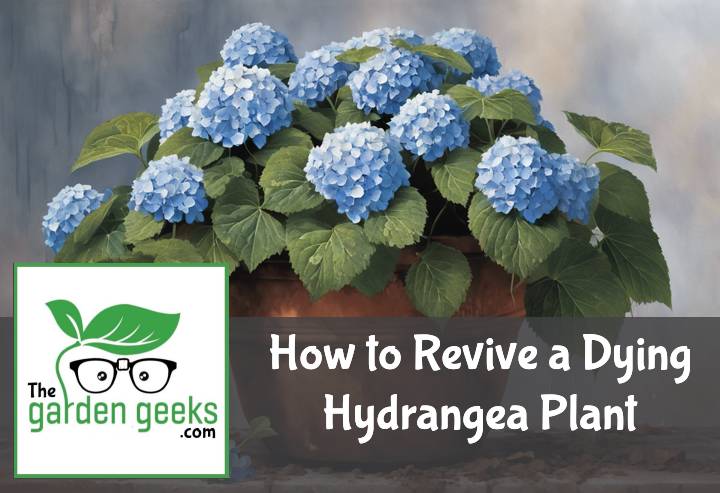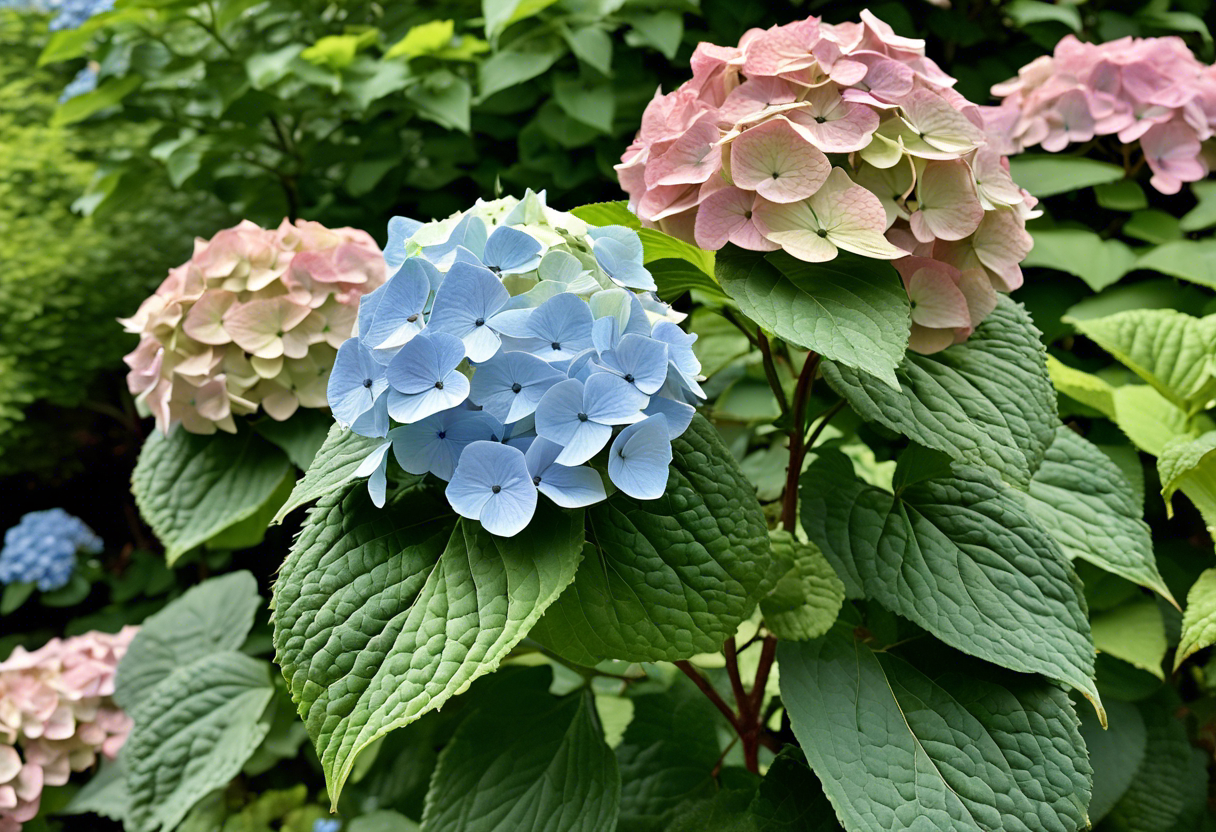Ever had a moment when you took one look at your hydrangea and thought, “Oh no, this doesn’t look good”? Well, I’ve been there. My once vibrant hydrangea started looking more like a Halloween prop than the lush beauty it used to be. But don’t worry! In our guide on How to Revive a Dying Hydrangea Plant, we’re going to help you breathe life back into your wilted friend.
So let’s roll up our sleeves and get to work. It’s time to play plant doctor and nurse our beloved hydrangeas back to health. Keep reading about How to Revive a Dying Hydrangea Plant.
Key Takeaways
- Identify signs of a dying hydrangea, such as wilting leaves or lack of blooms.
- Hydrate the plant thoroughly and regularly, but avoid overwatering.
- Ensure the plant is in a well-draining soil to prevent root rot.
- Place the hydrangea in an area with partial sunlight, avoiding direct afternoon sun.
- Prune dead or diseased parts of the plant to promote new growth.
- Use a balanced fertilizer to provide necessary nutrients.
- Monitor for pests and diseases, treating as needed.
Understanding Hydrangea Health
To revive a dying hydrangea plant, you gotta know your way around hydrangea care. It’s like being a plant doctor, diagnosing hydrangea health issues and prescribing the right treatment. You’re not just maintaining healthy hydrangeas, but also playing detective to spot signs of unhealthy hydrangeas. And trust me, common hydrangea diseases can be as tricky as a whodunit mystery!
Identifying Signs of a Dying Hydrangea
So how do you catch these sneaky culprits? Start by recognizing dying hydrangea symptoms. Unhealthy hydrangeas are like teenagers – they show their mood with colors. Keep an eye out for wilting hydrangea leaves or discoloration in hydrangeas. If your plant’s leaves look more yellow than a lemonade stand in summer, that’s a sign of sick hydrangeas.
Common Diseases and Pests Affecting Hydrangeas
Now let’s talk about the usual suspects – the diseases and pests affecting hydrangeas. These baddies are the common causes behind most hydrangea problems. From leaf spots to powdery mildew, these diseases can turn your green thumb blue! And don’t get me started on pests – they’re like uninvited guests who crash your garden party and munch on your plants! But don’t worry, dealing with sickly hydrangeas and managing pests in hydrangeas is all part of the game when learning how to revive a dying Hydrangea plant.
Causes of Hydrangea Decline
Hey, green thumb! Ever wondered why your hydrangea is looking a bit under the weather? Well, there are a few culprits that might be causing your dying hydrangea plant to wilt. These include improper watering, not enough sunlight, and poor soil conditions. Let’s dive into these hydrangea decline causes.
Improper Watering Practices
First off, let’s talk about water – too much or too little can both spell trouble for your hydrangeas. Overwatering can lead to root rot, while underwatering can leave your plant parched and wilting. If you’re seeing yellow leaves or drooping stems, you might be guilty of one of these watering practices for hydrangeas. Remember, balance is key when it comes to hydration!
Inadequate Sunlight Exposure
Next up on the list of reasons for hydrangea death is lack of sunlight. Hydrangeas love the sun – but not too much! They need about four hours of dappled light each day to thrive. So if your plant’s leaves are pale or its blooms are sparse, it might be crying out for more rays. Keep an eye on those hydrangea sunlight requirements, folks!
Poor Soil Conditions
Finally, let’s get down and dirty with soil conditions. The health of your hydrangea heavily depends on the quality of its soil home. Factors like pH level (they prefer slightly acidic), nutrient content (they love rich organic matter), and good drainage all play a part in keeping your plant happy and healthy. So don’t overlook the importance of soil quality for hydrangeas in learning how to revive a dying Hydrangea plant!
Reviving Your Hydrangea
Alright, let’s dive into the nitty-gritty of how to revive a dying hydrangea plant. We’re talking about adjusting watering techniques, modifying light exposure, and improving soil quality. These are your go-to hydrangea revival tips.
Adjusting Watering Techniques
First things first, water is life for your hydrangeas. But hey, it’s not just about drenching them in H2O. It’s about doing it right! Overwatering can be as bad as underwatering when it comes to hydrangea care.
So, how do you strike that balance? Well, these plant hydration methods aren’t rocket science. You need to adjust your watering based on the weather and soil moisture levels. If the top inch of soil feels dry – it’s time to water!
Remember, overwatering leads to root rot which is a common cause of a dying hydrangea. So keep an eye on those watering habits!
Modifying Light Exposure
Next up is light exposure. Hydrangeas love sunlight but too much of anything isn’t good, right? The trick here is understanding your plant’s needs and adjusting accordingly.
Hydrangeas typically need full morning sun and afternoon shade. Too much direct sunlight can scorch leaves while too little can lead to fewer flowers.
So play around with the location until you find that sweet spot where your hydrangea gets just enough rays but not too much heat! This way you’ll be able to handle any sunlight impact on hydrangeas like a pro!
Improving Soil Quality
Last but definitely not least is soil quality! Good soil equals happy plants – simple as that!
The ideal soil for hydrangeas should be rich in organic matter and well-draining. If the soil is poor or compacted, it can cause root problems and hinder growth.
So, don’t be shy to add some compost or organic matter to improve the soil structure. And remember, a little bit of love (and good soil) goes a long way in reviving plants!
Preventive Measures for Future Health
A stitch in time saves nine, right? Well, the same goes for your hydrangeas. Preventive gardening is key to keeping your plants blooming and vibrant. It’s all about regular pruning, monitoring for pests and diseases, and overall hydrangea care.
Regular Pruning and Maintenance
Let’s talk about hydrangea pruning. It’s like a spa day for your plant! Regular pruning not only keeps your hydrangea looking neat but also promotes better air circulation. This helps prevent fungal diseases that can turn your green thumb blue.
But wait, there’s more! Pruning also encourages new growth. So you’re not just maintaining your plant; you’re giving it a boost too! And who doesn’t love a good boost? Remember, plant maintenance isn’t a chore; it’s an investment in healthy hydrangeas.
Monitoring for Pests and Diseases
Now onto the less glamorous side of gardening – pests and diseases. No one likes them, but they’re part of the package. Early detection is crucial here folks! Keep an eye out for any changes in leaf color or shape. These could be signs of trouble brewing.
Got aphids? Don’t panic! There are plenty of ways to deal with these pesky critters without resorting to harsh chemicals. The same goes for common diseases like powdery mildew or leaf spot.
Remember, knowledge is power when it comes to garden pest control and plant disease prevention. So stay vigilant, act fast, and keep those hydrangeas happy!
And that’s how you learn ‘How to Revive a Dying Hydrangea Plant‘. But remember folks, prevention is always better than cure!
To Wrap Up
So, we’ve been through the hydrangea ICU, and you’re now equipped with the know-how to nurse your wilting beauty back to health. Remember, reviving a dying hydrangea is like teaching a goldfish to swim – it’s all about patience and persistence!
Finally, don’t forget to check out How to Revive a Dying Hydrangea Plant for more tips. Happy gardening folks!





